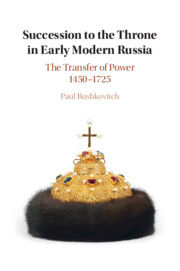Book contents
- Succession to the Throne in Early Modern Russia
- Succession to the Throne in Early Modern Russia
- Copyright page
- Contents
- Preface
- Acknowledgments
- 1 Succession to the Throne, Autocracy, and Absolutism
- 2 Designation and Heredity 1450–1533
- 3 Benediction to Election 1533–1598
- 4 Election and Heredity 1598–1645
- 5 Succession and the New Culture of the Court 1645–1689
- 6 Peter the Great and Succession 1690–1719
- 7 Peter’s Heirs and Feofan Prokopovich 1719–1725
- Epilogue and Conclusion
- References
- Index
1 - Succession to the Throne, Autocracy, and Absolutism
Published online by Cambridge University Press: 29 March 2021
- Succession to the Throne in Early Modern Russia
- Succession to the Throne in Early Modern Russia
- Copyright page
- Contents
- Preface
- Acknowledgments
- 1 Succession to the Throne, Autocracy, and Absolutism
- 2 Designation and Heredity 1450–1533
- 3 Benediction to Election 1533–1598
- 4 Election and Heredity 1598–1645
- 5 Succession and the New Culture of the Court 1645–1689
- 6 Peter the Great and Succession 1690–1719
- 7 Peter’s Heirs and Feofan Prokopovich 1719–1725
- Epilogue and Conclusion
- References
- Index
Summary
In the medieval and early modern West succession to the throne of monarchs proceeded by primogeniture, with some explicit legal basis. In medieval Russia political theory as such did not exist. Monarchy was understood in the context of Orthodoxy. The main form of discussion was in texts that provided images of good and bad monarchs, primarily chronicles, world histories, and the lives of saintly princes. In Russia succession was frequently collateral, a system that caused many disputes until the middle of the fifteenth century.
Keywords
- Type
- Chapter
- Information
- Succession to the Throne in Early Modern RussiaThe Transfer of Power 1450–1725, pp. 1 - 32Publisher: Cambridge University PressPrint publication year: 2021

